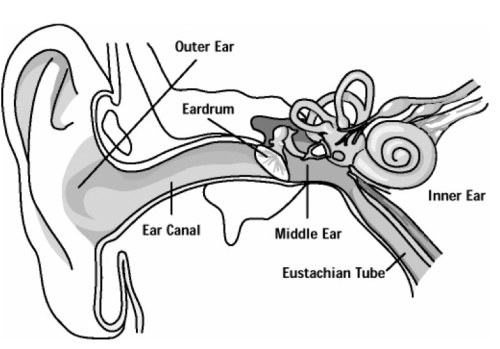Ear infections are a VERY common condition in pediatrics. In fact, ear infections are the most common bacterial infection in children. $3 BILLION dollars are spent on ear infections each year. 80% of kiddos will have had an ear infection before kindergarten and most kids have one to three ear infections in the first years of life. Here are FIVE points to know about ear infections:
- Ear Anatomy. To understand why children get ear infections, you have to know a bit about the ear anatomy. Above is a diagram of the ear. The external ear is the outermost portion including the ear cartilage that we can all see and the external canal where the doctor looks in to search of jelly beans, carrots, and monkeys. The middle ear starts with the tympanic membrane. The tympanic membrane is a thin translucent window that your doctor can look through to see if there is an infection within the middle ear. The middle ear space, as you can see in the picture, contains the tiniest bones of the body which vibrate to transmit sound to the inner ear. The middle ear space is special in that it connects to the throat through the eustachian tube. In children, the eustachian tube is flat and narrow. Past the middle ear, we find the inner ear space, which contains the special apparatus that converts the vibratory sound waves into electrical impulses that our brain interprets as sound.
- Eustachian tube dysfunction predisposes to ear infections. Ever notice how ear infections almost always are preceded by a cold? The eustachian tube is lined by the same cells that line the nose and throat. When a cold occurs, those cells get inflamed and swell, producing the snot that we all know and love. The same swelling and inflammation occurs in the eustachian tube. Normally, the eustachian tube is open and allows for pressure equalization between the middle ear and the throat. If you’ve ever popped your ears on an airplane or felt a click when you yawned, you have felt your eustachian tube in action equalizing the pressure. When the cells of the eustachian tube swell, the tube gets blocked off. Fluid accumulates in the eustachian tube and backs up into the middle ear space since it cannot escape in the the throat. Fluid buildup causes pressure to increase in the middle ear, causing pain. Hearing can also be affected because fluid in the middle ear dampens the vibration of sound through the tiny ear bones.
- Middle ear fluid sets up for middle ear infection. Many times, a child with a cold has fluid in the ear which does not get infected. I often tell parents that their child has a cold and there is fluid behind the ear, but no active infection is seen. I then warn them that the fluid could get infected tomorrow and they should watch for symptoms (new fever, worsening pain, etc.) which could indicate an ear infection has developed. The fluid in the middle ear is a great medium for bacteria to grow in. Bacteria from the nose and throat can make their way up the eustachian tube and cause an infection to develop. It’s possible to tell the difference between uninfected fluid (middle ear effusion) and infected fluid within the middle ear – effusions look like mostly clear fluid whereas infected fluid is often thick and cloudy colored.
- Prevent ear infections by preventing colds. Ear infections occur when fluid in the middle ear gets infected so the best way to prevent ear infections is to prevent fluid from developing in the middle ear. Colds are the most common reason for middle ear fluid – so just prevent your kiddo from getting a cold, right? Easier said than done! Did you know there are TWO vaccines that help prevent ear infections? Pneumococcal (Prevnar) and Haemophilus (Hib) vaccines are both targeted at bacteria that can cause serious blood, brain, and lung infections but are also the bacteria most commonly seen in ear infections. Hand-washing, on-time immunizations, and avoidance of sick kids (when/if possible) is the only way to prevent ear infections.
- Not all ear infections require antibiotics. The body is great at fighting infections. It is so great, in fact, that for hundreds of thousands of years (most) human beings survived without antibiotics! In the past, all ear infections were thought to require antibiotics to resolve. We know now that most ear infections resolve on their own and do not require antibiotics at all. There are brand new guidelines from the AAP on the treatment of ear infections which should help doctors know when a child actually needs an antibiotic (full details on these new guidelines will be a post for another day). A watch & wait approach is appropriate for many children. It is important, however, to be sure that in time the fluid accumulation in the ear resolves and so your child’s ears should be re-checked within a few weeks of an infection. Fluid that does not resolve can lead to hearing problems and speech delay. It also has the potential to become re-infected and restart the whole nasty process!
As children grow, their eustachian tubes get longer, stiffer, and more vertical – all things that help keep the tube open and prevent fluid build-up & ear infections. In the meantime, be on the lookout for snotty nosed kiddos and keep washing those hands!

